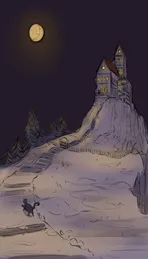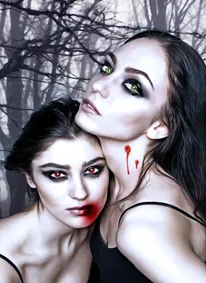
Imagen de Pixaby
¿Como se describe la figura del vampiro en la literatura? Hay dos corrientes con las que podemos contestar esta pregunta, por un lado tenemos a la criatura alta, de piel tan pálida por falta de sol que causa repulsión, colmillos afilados que sobresalen de los labios, orejas puntiagudas, ojos amarillentos, un ser que solo con ver produce desagrado y temor, que solo puede inducir un escalofrío en la espalda, solo con el sentir de su presencia, un verdadero espanto; con esta apariencia, se sabe, el peligro es inminente, esta allí, a la vuelta de la esquina, el depredador esta al asecho, esperando el momento indicado para acorralar y lograr su cometido, no importa cuanto se huya, logra encontrar la forma. Aun así estas no son las únicas características con las que se describe al vampiro, se presenta también como un ser misterioso, alto, delgado, blanco como la nieve y de labios rojos como la sangre, con gracia y elegancia, que te atrae y seduce con su voz, su mirar y con un movimiento casi hipnótico que logra modelar a la víctima a su antojo y sumergirla en su total control; este ser guía a su presa a su fatal destino haciéndolo sentir que es su decisión, que va tras la búsqueda de su instinto primitivo de deseo y seducción, aunque todo esto no es mas que la mortal trampa de ese ser exquisito, que utiliza su apariencia para apoderarse de nuevas almas para saciar su ser de sangre y sadismo.
How is the figure of the vampire described in literature? There are two currents with which we can answer this question, on the one hand we have the tall creature, with skin so pale for lack of sun that causes repulsion, sharp fangs protruding from the lips, pointed ears, yellow eyes, a being that only with the sight produces displeasure and fear, which can only induce a shiver in the back, only with the feeling of his presence, a real fright; With this appearance, you know, the danger is imminent, it is there, just around the corner, the predator is lying in wait, waiting for the right moment to corner and achieve its goal, no matter how much you run away, it manages to find a way. Yet these are not the only characteristics with which the vampire is described, it is also presented as a mysterious being, tall, thin, white as snow and blood red lips, with grace and elegance, which attracts and seduces you with his voice, his look and with an almost hypnotic movement that manages to shape the victim at will and submerge it in his total control; this being guides his prey to his fatal destiny making him feel that it is his decision, that he goes after his primitive instinct of desire and seduction, although all this is nothing more than the deadly trap of this exquisite being, who uses his appearance to seize new souls to satiate his being of blood and sadism.
Reconocer las situaciones de miedo y peligro es un instinto natural del ser humano, cuando se esta en un momento que producen estas sensaciones, la reacción subsiguiente es buscar la forma de sobrevivir a toda costa, la adrenalina es el impulso, que da la voluntad de luchar contra del villano que pone en riesgo la supervivencia. A diferencia de lo anterior expuesto, este mecanismo que busca perseguir la vida, no se activa cuando la presa es atraída al foco del peligro, envuelta en una de mentiras e ilusiones, muchas veces interpretadas de forma muy sutil como erotismo, seducción y el deseo de lo que de alguna manera se presenta como un depredador sexual.
Recognizing situations of fear and danger is a natural instinct of the human being, when one is in a moment that produces these sensations, the subsequent reaction is to look for the way to survive at all costs, adrenaline is the impulse, which gives the will to fight against the villain that puts survival at risk. Unlike the above, this mechanism that seeks to pursue life, is not activated when the prey is attracted to the focus of danger, wrapped in one of lies and illusions, often very subtly interpreted as eroticism, seduction and desire of what is somehow presented as a sexual predator.
Los relatos vampíricos aparecen a finales del siglo XVIII en un entorno donde la mentalidad era estricta en cuanto a las convicciones sociales, en este contexto se generan estas criaturas idílicas que se manifiestan como el reflejo del instinto animal primitivo del ser humano, encontrado siempre en el interior del pensamiento en la lucha constante del ser, y el deber ser impuesto por la sociedad. Es en los clásicos literarios de vampiros donde se denota su practica como la de un ser que se ocultaba bajo el manto frío de la noche oscura para entrar en silencio, sin permiso, ni invitación en las habitaciones de señoritas, jóvenes campesinas a realizar lo que escriben los autores como el hurto de su pureza e inocencia, marcándolas en el cuello y chupando su sangre. Dracula liberaba a las mujeres haciendo que disfrutasen de su sexualidad, algo que tenían prohibido en la época.
Vampire stories appear at the end of the eighteenth century in an environment where the mentality was strict in terms of social convictions, in this context these idyllic creatures are generated as the reflection of the primitive animal instinct of human beings, always found inside the thought in the constant struggle of being, and the duty to be imposed by society. It is in the literary classics of vampires where his practice is denoted as that of a being who hid under the cold cloak of the dark night to enter silently, without permission or invitation in the rooms of young ladies, young peasant girls to perform what the authors write as the theft of their purity and innocence, marking them in the neck and sucking their blood. Dracula liberated women by making them enjoy their sexuality, something that was forbidden at the time.
Es explicado en varios escritos como el momento de la alimentación produce en la víctima y victimario, extraña sensación de excitación. El vampiro era una forma de expresión, un modo para librarse de la represión sexual de la época victoriana, oculto en el escrito gótico, se generaba un medio para la exploración de nuevas temáticas que no serian exactamente bien vistas por la sociedad de la época, llegando así incluso a representar la homosexualidad en momentos en los que esto era visto como locura y se penaba con la horca. Estas novelas eróticas, se escondían en el terror del sadismo sangriento del personaje, y solo dejaban ver su verdadera naturaleza una vez el lector ya estaba lo suficientemente atrapado y sumergido en el encanto inherente del drama, se encuentra tan enganchado en la relación que se genera entre el temor de la figura fría de la muerte y la seducción generada por esta.
It is explained in several writings as the moment of feeding produces in the victim and victimizer, strange sensation of excitement. The vampire was a form of expression, a way to get rid of the sexual repression of the Victorian era, hidden in the gothic writing, it generated a means for the exploration of new themes that would not be exactly well seen by the society of the time, even representing homosexuality at times when this was seen as madness and was punishable by hanging. These erotic novels were hidden in the terror of the character's bloody sadism, and only revealed their true nature once the reader was sufficiently trapped and immersed in the inherent charm of the drama, so hooked in the relationship that is generated between the fear of the cold figure of death and the seduction generated by it.

Imagen de Pixaby
En evidencia la novela, Carmilla de Joseph Sheridan Le Fanu publicada en 1872, antes incluso que Dracula, es el mejor ejemplo del uso del misterio y terror para encubrir las oscuras tentaciones de la época, retratando a una mujer que no puede ser descrita como algo mas que una belleza etérea y su relación con la inocente e incauta jovencita que le da posada y comida, con la que llega a tener una amistad que confunde lo romántico y lo emocional, en una época donde el tabú de esa conexión, hubiera sido la condena de los personajes; en el cuento Carmilla manipula a Laura durante el sueño, siendo susceptible a sus terribles deseos de la misma forma que actuaria un súcubo, haciendo una clara referencia a lo anteriormente mencionado.
In evidence the novel, Carmilla by Joseph Sheridan Le Fanu published in 1872, even before Dracula, is the best example of the use of mystery and terror to cover up the dark temptations of the time, portraying a woman who cannot be described as anything more than an ethereal beauty and her relationship with the innocent and unwary young girl who gives her room and board, with whom she becomes friends in a friendship that confuses the romantic and the emotional, at a time when the taboo of such a connection would have been the condemnation of the characters; In the story Carmilla manipulates Laura during the dream, being susceptible to her terrible desires in the same way a succubus would act, making a clear reference to the aforementioned.
Todo lo anteriormente expuesto, da a entender que la figura del vampiro era un recurso literario, una metáfora del los impulsos sexuales y en algunos casos homosexuales, en donde la criatura, el no muerto, es un ser de apariencia común, que oculta su verdadera naturaleza para evitar el rechazo persecutorio de la sociedad victoriana ortodoxa que lo rodea, enredando al lector en una historia de terror que a profundidad plantea mas que misterio y suspenso
All of the above, suggests that the figure of the vampire was a literary resource, a metaphor for sexual impulses and in some cases homosexual, where the creature, the undead, is a being of common appearance, which hides its true nature to avoid the persecutory rejection of the orthodox Victorian society that surrounds it, entangling the reader in a horror story that in depth raises more than mystery and suspense.
